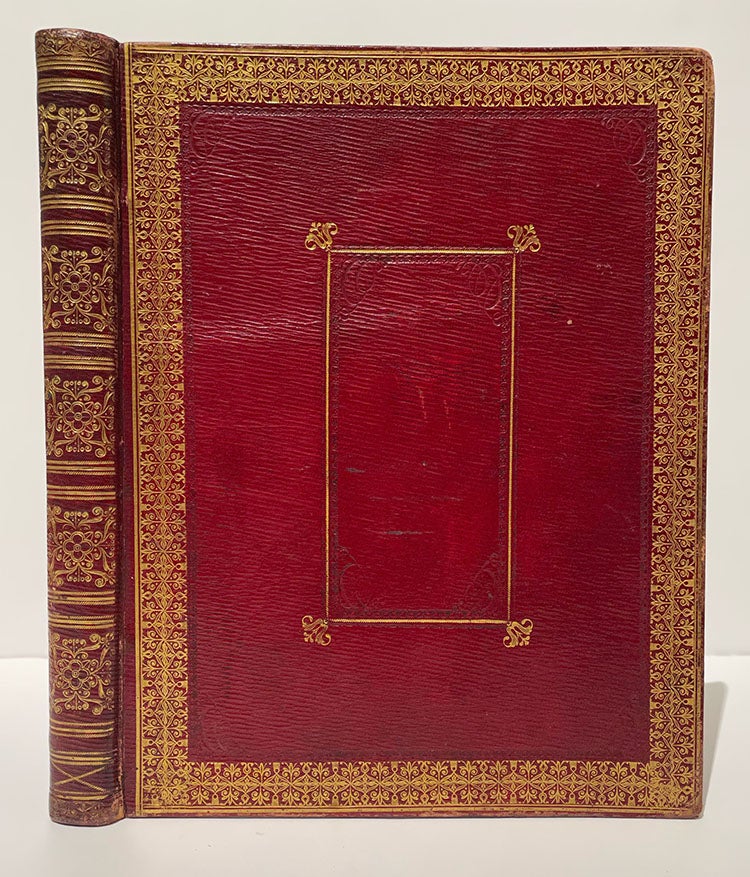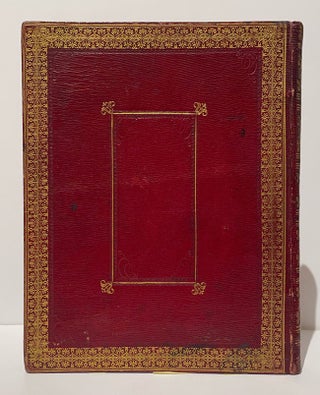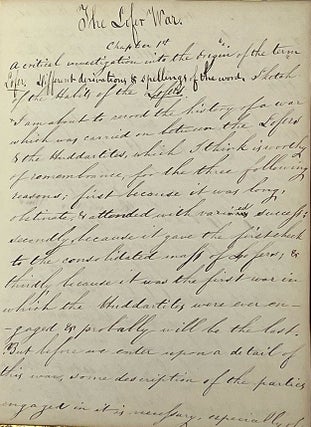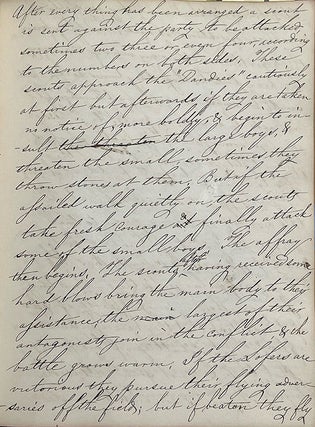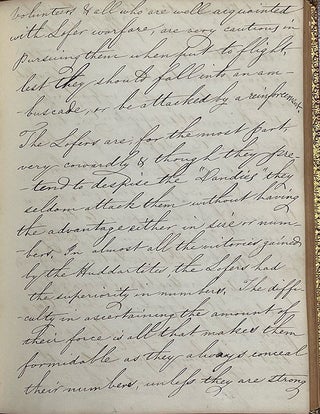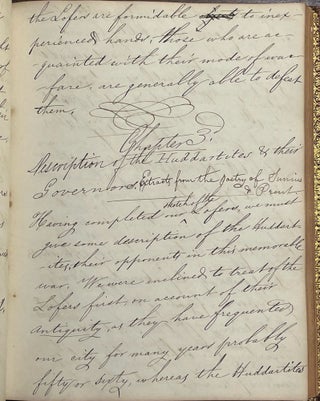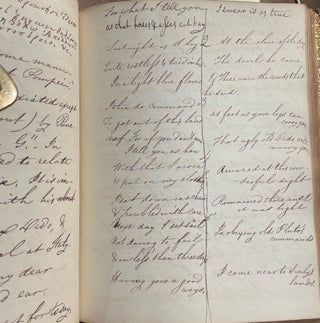The Lofer War. Being an account of a long & obstinate war, Carried on between the Huddartites & the Lofers, together with some account of that extraordinary People. Compiled by Herman Confucius from fragments found among the papers of the late Peter Confucius, & from the notes of Oroondates Mauran Jr., & a correspondent.
Place and Imprint: [Hellgate, East River, New York, circa 1835.],
Condition: Binding a little rubbed; in fine condition, enclosed in a recently-made quarter morocco clamshell box.
Book ID: 28651
Physical Description
4to, contemporary American red morocco, upper and lower boards with a center rectangular gilt border with floral corners, edges with a 1.5 cm floral-gilt border, spine elaborately gilt decorated in five compartments, marbled paper endpapers, a.e.g. Ticket of Arnold & Grubb, Bookseller and Binders, 289 1/2 Main St., Poughkeepsie, on the paste-down.Comments
A remarkable holograph manuscript by New York writer and man of letters Charles Astor Bristed (1820-1874), written when he was a teenager and under the supervision and care of his famous grandfather, John Jacob Astor - many years prior to his first published book. Bristed’s manuscript is in two parts, bound téte-bêche style (sometimes referred to as a “dos à dos” binding) with 86 unpaginated leaves (172 pages) legibly written in ink on the rectos and versos, numerous corrections in the text, bound in a fine quarto notebook, with Bristed’s signature (“Charles Bristed”) and also that of Eliza Matilda Astor. “The Lofer War,” with 112 pages, is the substantial part of the manuscript; the second part is a fair copy, also in Bristed’s holograph, of the poem “Fanny” by poet, family friend and private secretary to J. J. Astor, Fitz-Greene Halleck. “The Lofer War” is part roman à clef chronicle of the Knickerbocker world of New York as the young Bristed was witnessing it and part a work of imagination “after the manner of Sallust’s Jugerthine War,” i.e., it combines historical accuracy with fiction, “which the reader is at liberty to believe or not.” Following an elaborate table of contents that outlines the seven chapters, Bristed expounds on the derivation of the word “Lofer” and how it applies to the “lounging, lazy vagabonds who pass their time by getting into rows and insulting their betters,” who live by “hook or crook” and have in common “their aversion to respectable persons whom they call Dandies . . . a bitter hatred against all those who are better dressed than themselves.” The young Charles Astor Bristed clearly belonged to the rank of the Dandies and probably was accosted and picked on by bullies in the parks and streets of New York, whom he describes as “Lofers.” It was, he writes, a class conflict: “the agrarian principle, the poor against the rich and the rich against the poor.” Bristed attended a school in New York founded by Rev. Richard Townsend Huddart, called the Classical Institute. He describes his fellow classmates as “Huddartites,” who eventually go to war with the Lofers, a conflict which he chronicles in detail, including the tactics of each side; how the Lofers use Battery Park and other hideouts and hangouts to attack fire volunteers, schools and scholars; how they throw rocks and break windows and confront anyone who represents order and respectability. Though they are outnumbered, the Huddarties prevail in the end, though the future remains uncertain. Bristed’s tale also includes numerous references to contemporary literature and characters, both real (William Henry Herbert, James Fenimore Cooper and Davy Crockett) and invented: a poet named Punctilious Prout, Esq.; the late Peter Confucius (author of Lays & Tales of a Prison and compiler of the notes for the manuscript of the Lofer Wars); a poet named Junius; and Oroondates Mauran Jr., an “excellent comic writer” and author of the forthcoming Sketchbook of a Huddartite, a probable nod to Washington Irving, another Astor family friend. A remarkable manuscript for its firsthand look into the life of New York City - “the Good City of Gotham” as Bristed describes it - in the first part of the 19th century, as seen through the eyes of a young man of its uppermost class, who in telling his story displays his knowledge of classical and modern literature, Greek, Spanish, and frontier Americanisms. The second part of the manuscript is a fair copy of the poem by Fitz-Greene Halleck, first published in 1819, that was a popular satire of the literature, fashions and politics of the era and would have been a text that was familiar to the young Charles Astor Bristed. After attending Huddart’s Classical Institute, Bristed attended Columbia College, after which he matriculated to Yale, where he graduated in 1839; followed by Trinity College, Cambridge. Between the conclusion of his studies at Trinity College and his death in 1874, Bristed published more than 20 books and 200 articles on a wide variety of subjects, from classical literature to American society. Like many “Dandies” of his age, he split his life between New York and Europe. Bristed was well known and respected for his erudition and scholarship, of which this manuscript is a clear foreshadowing. The preliminary blank leaves contain other contemporary signatures, including that of Eliza Matilda Astor and a fair copy, in another hand, of a poem by Louisa Crawford that appeared in the Metropolitan Magazine in 1835. Hellgate is given as the location of the composition for that was the location of John Jacob Astor’s home on the East River, where Bristed lived during his formative years in New York. He moved in with his grandfather when he was twelve-years-old following the death of his mother.Price: $8,750.00
See all items in
American Literature,
Autographs & Manuscripts
See all items by CHARLES ASTOR BRISTED

